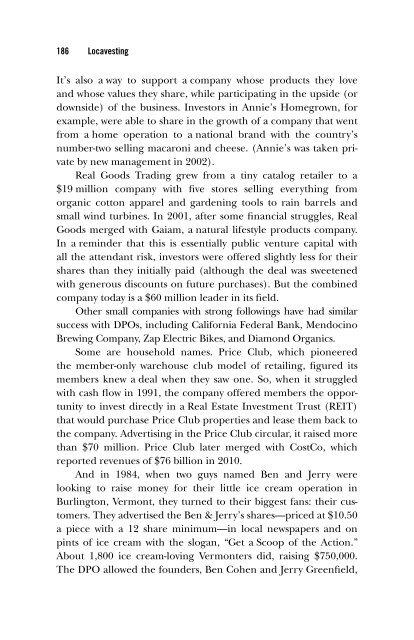3c hapter - Index of
3c hapter - Index of
3c hapter - Index of
Create successful ePaper yourself
Turn your PDF publications into a flip-book with our unique Google optimized e-Paper software.
186 Locavesting<br />
It’s also a way to support a company whose products they love<br />
and whose values they share, while participating in the upside (or<br />
downside) <strong>of</strong> the business. Investors in Annie’s Homegrown, for<br />
example, were able to share in the growth <strong>of</strong> a company that went<br />
from a home operation to a national brand with the country’s<br />
number- two selling macaroni and cheese. (Annie’s was taken private<br />
by new management in 2002).<br />
Real Goods Trading grew from a tiny catalog retailer to a<br />
$19 million company with fi ve stores selling everything from<br />
organic cotton apparel and gardening tools to rain barrels and<br />
small wind turbines. In 2001, after some fi nancial struggles, Real<br />
Goods merged with Gaiam, a natural lifestyle products company.<br />
In a reminder that this is essentially public venture capital with<br />
all the attendant risk, investors were <strong>of</strong>fered slightly less for their<br />
shares than they initially paid (although the deal was sweetened<br />
with generous discounts on future purchases). But the combined<br />
company today is a $60 million leader in its fi eld.<br />
Other small companies with strong followings have had similar<br />
success with DPOs, including California Federal Bank, Mendocino<br />
Brewing Company, Zap Electric Bikes, and Diamond Organics.<br />
Some are household names. Price Club, which pioneered<br />
the member- only warehouse club model <strong>of</strong> retailing, fi gured its<br />
members knew a deal when they saw one. So, when it struggled<br />
with cash fl ow in 1991, the company <strong>of</strong>fered members the opportunity<br />
to invest directly in a Real Estate Investment Trust (REIT)<br />
that would purchase Price Club properties and lease them back to<br />
the company. Advertising in the Price Club circular, it raised more<br />
than $70 million. Price Club later merged with CostCo, which<br />
reported revenues <strong>of</strong> $76 billion in 2010.<br />
And in 1984, when two guys named Ben and Jerry were<br />
looking to raise money for their little ice cream operation in<br />
Burlington, Vermont, they turned to their biggest fans: their customers.<br />
They advertised the Ben & Jerry’s shares—priced at $10.50<br />
a piece with a 12 share minimum—in local newspapers and on<br />
pints <strong>of</strong> ice cream with the slogan, “Get a Scoop <strong>of</strong> the Action.”<br />
About 1,800 ice cream- loving Vermonters did, raising $750,000.<br />
The DPO allowed the founders, Ben Cohen and Jerry Greenfi eld,
















